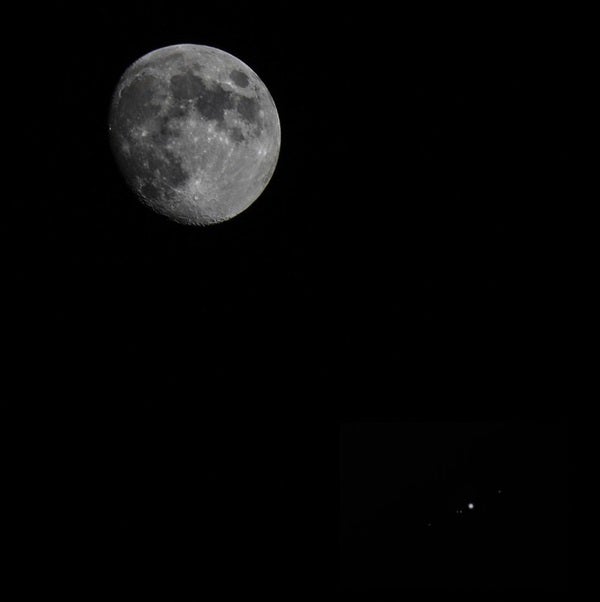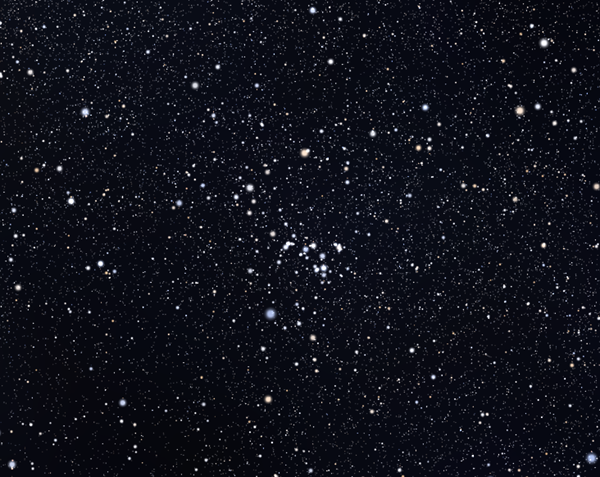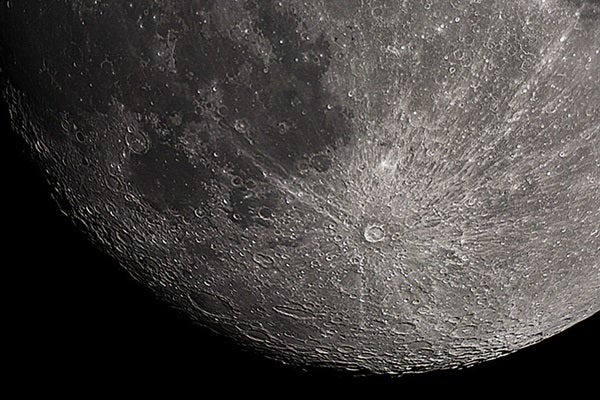We’ve now entered the tail end of the Alpha Capricornid and Delta Aquiariid meteor showers, both of which peaked overnight July 28/29. However, you might still spot sporadic shower meteors over the next few days, particularly in the early morning hours between moonset and sunrise.
Another nighttime sight that’s winding down is Comet C/2020 F3 (NEOWISE). The comet is about 50° high at sunset, although you’ll likely need to wait for the sky to darken before you can find it. It’s currently in the west-southwest, sailing through the constellation Coma Berenices. Observers report the comet is now magnitude 4, meaning it’s barely visible to the naked eye under good conditions. NEOWISE’s fuzzy coma and tail require binoculars or a small scope to really pick out, while stacked or long-exposure images will offer the best views.
Sunrise*: 5:58 A.M.
Sunset: 8:14 P.M.
Moonrise: 6:16 P.M.
Moonset: 2:46 A.M.
Moon Phase: Waxing gibbous (89%)
*Times for sunrise, sunset, moonrise, and moonset are given in local time from 40° N 90° W.

Astronomy is pleased to present The Complete Star Atlas, the perfect resource for stargazers of all ages. This practical guide to viewing the night sky is now available, and includes approximately 87,000 stars, 1,200 deep-sky objects, and 24 high-quality star maps. You’ll also find 50 pages of astronomy history, tips, and more from experienced Contributing Editor Michael E. Bakich.
The Moon passes 1.5° south of Jupiter at 8 P.M. EDT. You can find the pair already in the southeastern sky at sunset, rising higher as twilight fades. They’re located in Sagittarius, with Saturn nearby. The ringed planet glows at magnitude 0.2 and sits less than 8° due east of magnitude –2.7 Jupiter. With the Moon brightening the sky, it will be difficult to seek out fainter targets, so take some time tonight to enjoy the giant planets through binoculars or a telescope. For most of the night, only three of Jupiter’s largest moons are visible: Io, Ganymede, and Callisto. Europa is obscured first by the planet itself and then by its large shadow. The icy moon fully reappears around 1:45 A.M. E.D.T. on the 2nd.
Given the glare, it may be difficult to see most of Saturn’s moons. The largest and brightest — Titan — may stand out roughly 1.5′ northeast of the planet’s center. Additionally, focus on Saturn’s gorgeous rings; see if you can spot the dark Cassini division that separates the two brightest rings, A and B.
Tiny Pluto is also nearby; it’s sitting roughly between Jupiter and Saturn, less than 3.5° east-southeast of Jupiter. At magnitude 14.6 it’s a serious challenge requiring a large scope or a camera, particularly with the bright Moon so close.
Sunrise: 5:59 A.M.
Sunset: 8:13 P.M.
Moonrise: 7:12 P.M.
Moonset: 3: 40 A.M.
Moon Phase: Waxing gibbous (95%)
Sunday, August 2
The Moon continues its journey through Sagittarius this morning, passing 1.1° south of Pluto at 2 A.M. EDT and 2° south of Saturn at 9 A.M. EDT.
Magnitude –1 Mercury passes 7° south of Pollux at 2 A.M. EDT, although the pair won’t be visible for a few hours after that. An hour before sunrise, they’re both above the horizon: Mercury is just 2.5° high in the east-northeast, rising as the sky brightens. The planet appears just 6″ wide. Gold-hued Pollux is to Mercury’s north, with blue-white Castor to Pollux’s northwest. This is one of your last chances to catch Mercury before it sinks too low at dawn. It will reappear in the evening sky later this month, after reaching superior conjunction August 17.
Much easier to view will be magnitude –4.5 Venus, nearly 25° high in Taurus an hour before sunrise. The planet is 44 percent lit and spans 27″; you’ll find it less than 2° southeast of magnitude 3 Alheka and just over 15° east of magnitude 0.9 Aldebaran. And once you find the latter star, look about 14° directly above it to spot the Pleiades.
Sunrise: 6:00 A.M.
Sunset: 8:12 P.M.
Moonrise: 8:00 P.M.
Moonset: 4:39 A.M.
Moon Phase: Waxing gibbous (98%)
Monday, August 3
The Red Planet has already been in the news recently as several missions, including NASA’s 2020 Mars rover, Perseverance, have blasted off in its direction. Mars reaches perihelion — the closest point in its orbit to the Sun — today at 5 A.M. EDT. One Mars year is nearly twice as long as one Earth year, lasting 687 Earth days. At the moment of perihelion, Mars will be 128.4 million miles (206.6 million kilometers) from our star and nearly 58.6 million miles (94.2 million km) from Earth.
The Red Planet is up all morning and at 5 A.M. EDT, it’s almost 50° high in the southeast, near the border of Pisces and Cetus. Mars appears 15″ across and glows at magnitude –1.1, making it a great target for the naked eye, binoculars, or a telescope. Nearby are both Uranus (magnitude 5.8, 21.5° northeast of Mars) and Neptune (magnitude 7.8, 30° southwest of Mars), but both may be tricky to spot with the bright Moon not far away in Capricornus.
Full Moon occurs today at 11:59 A.M. EDT.
Sunrise: 6:01 A.M.
Sunset: 8:11 P.M.
Moonrise: 8:40 P.M.
Moonset: 5:43 A.M.
Moon Phase: Full
Globular star clusters are our galaxy’s oldest objects; these gauzy balls of stars are frequent targets for amateur observers, but globulars aren’t the only star clusters our galaxy holds. High in the sky after sunset is NGC 6633, an open star cluster of about 30 young stars in Ophiuchus. Born roughly 660 million years ago, this nearby cluster covers about the same area as the Full Moon in the sky. Binoculars will bring out its many stars, and a telescope will offer even sharper detail.
Just 3° east-southeast of NGC 6633 is another open cluster, IC 4756 in Serpens. Although the fainter of the two, IC 4756 is home to about 80 stars scattered across a region of sky twice as large. You may see them at first as a gauzy haze, but 4×70 or 16×70 binoculars should separate that haze into individual stars. With a large field of view, you’ll be able to get both clusters at the same time.
If possible, you’ll want to seek these targets out between the end of twilight and moonrise, when the sky is darkest and the best contrast can be achieved.
Sunrise: 6:02 A.M.
Sunset: 8:10 P.M.
Moonrise: 9:14 P.M.
Moonset: 6:46 A.M.
Moon Phase: Waning gibbous (99%)
Wednesday, August 5
The magnitude 8 dwarf planet Ceres lies 4.5′ from magnitude 3.6 88 Aquarii tonight. The pair should be high enough to observe an hour before midnight, but the bright Moon nearby will likely hinder the view. Normally visible in binoculars, you may want to pull out a small scope to help you find the tiny world against the bright background. However, Ceres is moving quickly enough that its motion relative to the background should be noticeable from hour to hour. Keep an eye on it overnight and into tomorrow morning to see if you can spot it.
If you’re still having trouble finding Ceres against the glare, try waiting a few days until the Moon has left the region to try again. Although Ceres is quickly fleeing 88 Aquarii, it’s still less than 1.5° from the star a week from today.
Sunrise: 6:03 A.M.
Sunset: 8:08 P.M.
Moonrise: 9:43 P.M.
Moonset: 7:49 A.M.
Moon Phase: Waning gibbous (97%)
The Moon passes 4° south of Neptune in Aquarius at 11 A.M. EDT. By late evening, the pair are 7° apart, with the Moon at the edge of the border between Aquarius and Cetus. Like Ceres last night, it may be hard to spot the dim planet (magnitude 7.8) amidst the Moon’s bright glow. Instead, consider focusing in on our satellite tonight, with most of its face still visible and only 8 percent hidden in shadow. The large, rayed impact crater easily visible in the southern highlands is Tycho, which measures 53 miles (85 km) across. Scientists think it formed from an impact about 108 million years ago. Over time, the bright rays will fade with prolonged exposure to space, which includes bombardment by micrometeorites and particles in the solar wind.
Sunrise: 6:04 A.M.
Sunset: 8:07 P.M.
Moonrise: 10:08 P.M.
Moonset: 8:50 A.M.
Moon Phase: Waning gibbous (92%)
Friday, August 7
By an hour after sunset, the familiar Summer Triangle formed by the stars Altair in Aquila, Deneb in Cygnus, and Vega in Lyra will be high in the sky. Take a tour of the Triangle’s delights tonight, focusing on the time between twilight and moonrise to seek out some of its fainter treasures.
One of those treasures is the stunning Ring Nebula (M57), a planetary nebula formed as a Sun-like star puffs away its outer layers at the end of its life. You can find M57 about 6.5° southeast of Vega and less than 1° east-southeast of magnitude 3.5 Sheliak (Beta [β] Lyrae). Through a small (4-inch) scope, the Ring appears as a pale gray sphere; crank up the magnification to bring out more detail, which will reveal that the outer edges of the sphere look thicker and darker than its center.
Nearby is M56, a magnitude 8.4 globular cluster in the eastern portion of Lyra. You should be able to snag it with binoculars from a dark site, while a telescope should show it even with some light pollution.
As the night wears on and moonrise approaches, skip over to Cygnus to view the beautiful bi-colored double star Albireo. Deneb forms the Swan’s tail, and Alberio the head. Of the pair, the magnitude 3.4 primary appears golden yellow, while its fainter magnitude 5.2 companion appears blue. The stars appear 35″ apart, easy to split under low magnification.
Sunrise: 6:04 A.M.
Sunset: 8:06 P.M.
Moonrise: 10:33 P.M.
Moonset: 9:50 A.M.
Moon Phase: Waning gibbous (86%)

Our exclusive Sky Guide 2020 is now available! This free downloadable pamphlet contains a month-by-month rundown of 2020’s biggest celestial events, from Mars’ best opposition in years to the return of totality in South America this December. Check out Astronomy’s Sky Guide 2020 now!












